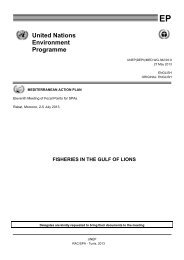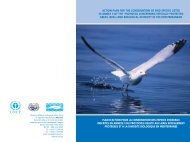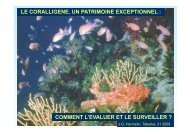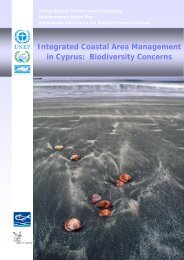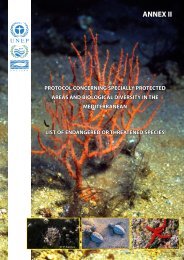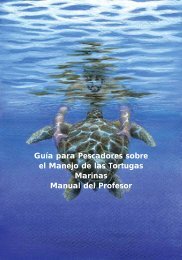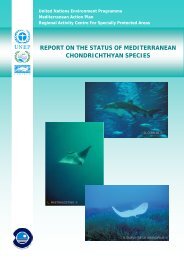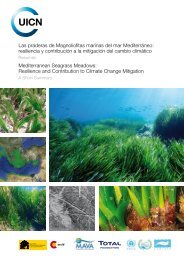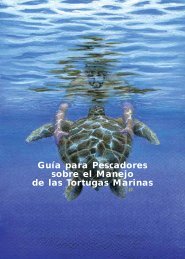Proceedings of the Second Mediterranean Symposium on Marine
Proceedings of the Second Mediterranean Symposium on Marine
Proceedings of the Second Mediterranean Symposium on Marine
Create successful ePaper yourself
Turn your PDF publications into a flip-book with our unique Google optimized e-Paper software.
On Fig. 4 each <str<strong>on</strong>g>of</str<strong>on</strong>g> <str<strong>on</strong>g>the</str<strong>on</strong>g> five stati<strong>on</strong>s c<strong>on</strong>tains four samples from four different m<strong>on</strong>ths.<br />
Dashed lines indicate <str<strong>on</strong>g>the</str<strong>on</strong>g> simulated mean from a 5000 random selecti<strong>on</strong>s from a master<br />
list <str<strong>on</strong>g>of</str<strong>on</strong>g> 513 species <str<strong>on</strong>g>of</str<strong>on</strong>g> <str<strong>on</strong>g>the</str<strong>on</strong>g> Greek seas. C<strong>on</strong>tinuous lines represent <str<strong>on</strong>g>the</str<strong>on</strong>g> 95% c<strong>on</strong>fidence<br />
intervals and define <str<strong>on</strong>g>the</str<strong>on</strong>g> area where any ∆ + or Λ + value, for a given number <str<strong>on</strong>g>of</str<strong>on</strong>g> species,<br />
lies within <str<strong>on</strong>g>the</str<strong>on</strong>g> “expected” range.<br />
Figure 4: Average tax<strong>on</strong>omic distinctness ∆+, and Variance in Tax<strong>on</strong>omic Distinctness Λ+ values, plotted<br />
against <str<strong>on</strong>g>the</str<strong>on</strong>g> observed number <str<strong>on</strong>g>of</str<strong>on</strong>g> species for two cases: using all groups <str<strong>on</strong>g>of</str<strong>on</strong>g> algae and excluding <str<strong>on</strong>g>the</str<strong>on</strong>g> red algae<br />
group.<br />
DISCUSSION AND CONCLUSIONS<br />
The EEI has adequate resolving power to discriminate between disturbed sites. From <str<strong>on</strong>g>the</str<strong>on</strong>g><br />
results in <str<strong>on</strong>g>the</str<strong>on</strong>g> specific area <str<strong>on</strong>g>the</str<strong>on</strong>g> EEI seemed to perform better when relative abundance<br />
data were used. Relative abundance intensifies <str<strong>on</strong>g>the</str<strong>on</strong>g> difference <str<strong>on</strong>g>of</str<strong>on</strong>g> percentages <str<strong>on</strong>g>of</str<strong>on</strong>g> <str<strong>on</strong>g>the</str<strong>on</strong>g> two<br />
Ecological State Groups <str<strong>on</strong>g>of</str<strong>on</strong>g> species proposed by Orfanidis et al., (2001).<br />
Tax<strong>on</strong>omic diversity indices can be very useful, as <str<strong>on</strong>g>the</str<strong>on</strong>g>y can perform <strong>on</strong> qualitative data,<br />
and <str<strong>on</strong>g>the</str<strong>on</strong>g>ir independence <str<strong>on</strong>g>of</str<strong>on</strong>g> sample size makes <str<strong>on</strong>g>the</str<strong>on</strong>g>m suitable for comparis<strong>on</strong>s <str<strong>on</strong>g>of</str<strong>on</strong>g> different<br />
regi<strong>on</strong>s, studies etc. Overall <str<strong>on</strong>g>the</str<strong>on</strong>g> two tax<strong>on</strong>omic distinctness indices performed better<br />
when <str<strong>on</strong>g>the</str<strong>on</strong>g> red algae group was excluded from <str<strong>on</strong>g>the</str<strong>on</strong>g> analysis. This could be due to <str<strong>on</strong>g>the</str<strong>on</strong>g> fact<br />
that <str<strong>on</strong>g>the</str<strong>on</strong>g> number <str<strong>on</strong>g>of</str<strong>on</strong>g> red algae species is three times greater than <str<strong>on</strong>g>the</str<strong>on</strong>g> number <str<strong>on</strong>g>of</str<strong>on</strong>g> <str<strong>on</strong>g>the</str<strong>on</strong>g> green<br />
and brown algae species. This is affecting <str<strong>on</strong>g>the</str<strong>on</strong>g> balance <str<strong>on</strong>g>of</str<strong>on</strong>g> <str<strong>on</strong>g>the</str<strong>on</strong>g> tax<strong>on</strong>omic tree and needs<br />
fur<str<strong>on</strong>g>the</str<strong>on</strong>g>r examinati<strong>on</strong>.<br />
ACTES DU DEUXIEME SYMPOSIUM MEDITERRANEEN SUR LA VEGETATION MARINE (ATHENES, 12-13 DECEMBRE 2003)<br />
221




